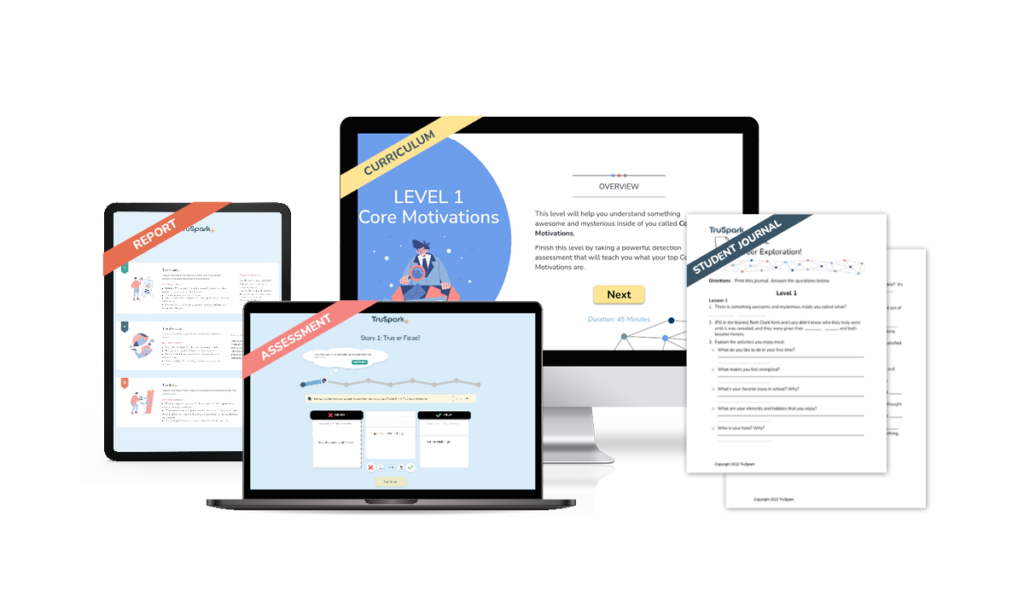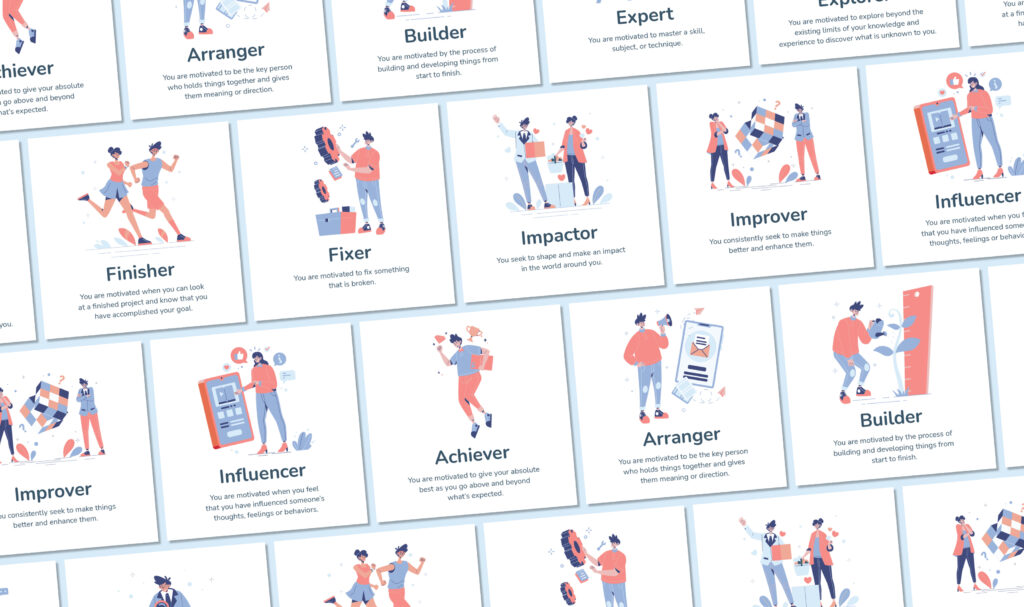A mentor once told me you can do anything if you possess the right knowledge and skills. He firmly believed these were the only two ingredients required for success. I have found, however, there is one more ingredient needed—motivation.
Consider the student with near failing grades and subpar academic achievement. But when it comes time to take the ACT, they crush it and get a top score, demonstrating superior subject knowledge and ability. How can such an intelligent student perform so poorly in their day-to-day work when they obviously possess the knowledge and skills to excel? Answer: motivation.
There are those who just naturally grasp math concepts, but they don’t like math. Or those who can draw beautifully, but are not inspired by art.
An ability, talent or skill does not automatically lead to success or achievement unless the person is engaged and committed to the endeavor.
- Haven’t we all seen great athletes quit because they simply lost their zest for the sport?
- Haven’t we all heard of that young professional who completes medical or law school, and then decides they don’t want to practice because it’s not a good fit?
When it comes to success in our personal or professional lives, ability and skill need to be complemented by core motivation that drives us to apply our sustained effort and stay engaged with the activity.

When we tap into core motivation, the activity is deeply rewarding.
Instead of feeling like a burden, it is a joy! Motivation, when applied to the right activities, turbo charges knowledge and skills, leading to amazing success!
What Is a Motivation Test?
A quality motivation test or motivation quiz looks at intrinsic motivations, those internal core drives that move an individual to be fully engaged with a task or behavior.
Most workplace managers think about external motivations, both positive and negative, like a raise or the threat of losing one’s job. But savvy leaders tap into what makes a person come alive and be at their best. This is the domain of intrinsic motivation, where the activity itself becomes the reward.
Leaders (including parents and teachers) who truly want to develop their team can use a motivation test to uncover intrinsic motivations and manage accordingly.
- That team member who wants to fix and improve existing processes should not play the same role as the person who wants to explore, build, or develop new products.
- The visionary thinker should have room to look for potential and ponder what can be, while the organizers can bring structure and planning to these big ideas.
How Do You Determine What Motivates You?
In the same way that every personality is unique, the combination of what motivates each individual is also unique. But unlike personality which abounds with various frameworks, quizzes, and tests, there are very few motivation assessment tools.
Those that have been developed recently employ a unique approach to helping you determine what motivates you: They start with your own stories.

What Motivates Me Quiz
For example, TruSpark asks students to think about some of their own achievement stories, times they’ve done something well and felt really good about it. As an individual reflects on these stories, they are getting in touch with the types of activities and settings that help them come alive and find a deep sense of satisfaction. As this process unfolds, so do the core motivations that drive someone to show up fully engaged in their work.
In fact, when motivations are being expressed, work doesn’t even feel like work!
The content of some people’s stories will involve interaction with others, helping people out or working in a team environment. Others have achievement stories that are more individual in nature, standing out from the crowd, meeting the challenge, or being unique.
Once the stories are identified, these motivation assessments, like TruSpark, walk an individual through a process of identifying the aspect of the activity they found most deeply rewarding. This story-based approach has proven to be a powerful way to determine what motivates you.
How Do I Find My Motivation?
A great way to find your motivation is to reflect on times in your life when you’ve done something well, and really enjoyed doing it. Consider those things that are truly life-giving. They don’t have to be impressive to others; they just need to stand out in your mind.
For some people, it is as simple as completing a task, quietly fixing something that was broken, or helping a person in need. For others, their stories involve deep exploration, winning a competition, or standing out as unique from the crowd.
Our most rewarding stories reveal our deepest core motivations.
There are tests, like TruSpark, that walk an individual through this type of discovery process. Once motivations are identified and understood, you can begin to look for ways to bring them into your daily work and professional life.
When we’re operating in tune with our core motivations, we often show up as our best selves, doing our best work.
Consider a person who tells a story about fixing their car and the process of researching the problem and learning to repair it themself rather than taking it into the mechanic. After rating this story in the TruSpark assessment process, they learn their motivations are fixing things and being a key person in the solution. Now they can take this knowledge to their next job interview and describe how they love to find ways to solve problems and be a central figure in leading that process of providing solutions. Not only is it true, but it demonstrates a powerful level of self-knowledge and insight.
What Are Key Motivators?
Key motivators are internal, sometimes called intrinsic motivators where the activity itself is the reward. Why else would someone do a crossword puzzle every day? Nobody is paying them to do this activity. There is no threat of being punished if they don’t do it. So why would they spend so much time every week completing this activity?
The answer is there is something in the task that is tapping into a key motivator for that person. For some, it is about meeting the challenge, or bringing the task to completion. For others, it might be about exploring, learning, or mastering their technique. It is hard to tell just by observing the behavior; individuals must weigh in and describe what they find most rewarding about such a task.
TruSpark’s Core Motivations
Core Motivation Test
TruSpark motivation quiz outlines 19 different key motivators that can be discovered through a unique assessment process.
Some of these 19 motivations have to do with excelling and meeting challenges. These people are the:
- Achievers
- Overcomers
- Standouts
Some involve learning, discovering and demonstrating what you’ve learned. These people are the:
- Experts
- Learners
- Teachers
- Explorers
Some motivations are centered on aspects of the process itself. These people are the:
- Finishers
- Fixers
- Improvers
- Organizers
- Arrangers
- Builders
We see some motivations that are very involved and even dependent on other people. These are the:
- Helpers
- Team Players
- Influencers
- Impactors
And finally, there are motivations that have to do with recognizing potential and bringing it into reality. These are the:
- Maximizers
- Visionaries
Learn more about each CM here.
What Moms Say About Discovering Their Teens’ Core Motivations
@marywilsonblog #ad Learn more about the @mytruspark core motivations assessment on my blog or their website. #homeschoolingteens #homeschoolmom #homeschoolhighschool ♬ original sound – Mary Hanna Wilson | Homeschool
Extrinsic and Intrinsic Motivations
As psychologists have studied and theorized about what motivates people, they have broken motivation into two main buckets called extrinsic (external) motivation and intrinsic (internal) motivation.
Extrinsic Motivations
Extrinsic motivations stem from external feedback centered around reward and punishment. With extrinsic motivations, people do certain behaviors expecting to gain something or be rewarded. For example, think about the person who comes to work everyday at a job they don’t like simply to earn a paycheck so they can pay their bills.
Because of extrinsic motivations, we also perform certain behaviors to avoid punishment or negative consequences. Consider a person who begrudgingly pays their taxes every year mainly to avoid an audit, fine, or penalties.
Intrinsic Motivations
Intrinsic motivations, on the other hand, stem from an internal sense of satisfaction and enjoyment. The activity itself is rewarding to that individual.
Think about a person who volunteers each week at a food pantry because they find it satisfying to help others, or the person who works hard to finish a project because they like the feeling of bringing things to completion.
In the long run, intrinsic motivation is much more enduring and meaningful. It’s only in the realm of intrinsic motivations that a person can experience a sense of flow and fulfillment.
With internal motivations, the behavior itself is the reward.
Where Does TruSpark Fit? Extrinsic or Intrinsic?
TruSpark is unique in that it is a motivational assessment tool which looks at intrinsic motivations. In all, TruSpark defines 19 different types of intrinsic, or core motivations that help students understand the types of behavior and activity they’ll find truly rewarding and lifegiving.
Projective Versus Objective Tests
A second unique attribute of the TruSpark motivation test is how it combines profoundly different assessment approaches into one cohesive process. There are two main types of psychological tests: projective tests and objective tests.
What Is an Objective Test?
The objective test requires the respondent to choose a particular response to a structured set of options (e.g., true/false, agree or disagree, or pick an answer from the list provided).
A good example of an objective test is a personality quiz that asks which words or phrases best describe a person. Every respondent gets the exact same set of questions and response options.
What Is a Projective Test?
The projective test is more flexible, and even ambiguous, in order to allow the respondent an opportunity to project his or her own interpretation and thoughts into their responses.
A good example is the inkblot test, otherwise known as the Rorschach, or projective drawing tests that encourage people to draw a picture of a house, tree, or person. A person’s mood, personality, or unique circumstances will often surface as a theme throughout the projective process.
TruSpark: A story-based motivation quiz for teens

TruSpark is unique in that it is one of the only motivation tests out there that combines the openness of a projective test with the structured options of an objective test.
The Story Element of TruSpark Is Projective
In Truspark, students are asked to think of two stories of achievement—times they did something well and felt good about it. They compose a few sentences, describing the experience and what they did. This story-based aspect is the projective portion of TruSpark since they can pick any stories that fit the criteria of something they did well and felt good about.
The Card Sorting Element of TruSpark Is Objective
Next, they begin sorting 19 cards, each with a unique statement that reflects a core internal motivation. In this card sort process, they choose only those statements that are true of their story and deeply rewarding. This is the objective portion of the assessment since the same 19 cards are presented to each respondent. In the end, the students narrow the cards down to a final few as they select and rank their top 3 key motivators across two achievement stories.
With TruSpark, the motivation assessment scale scoring is done with sophisticated AI programming. Once these intrinsic motivations are identified in the individual’s achievement stories, the TruSpark AI maps a blueprint of the three top Core Motivations that are most life-giving to them.
What Motivates You at Work Quiz
Not only does TruSpark stand alone as an assessment of intrinsic motivation that combines both projective and objective techniques, but TruSpark goes a step further into career exploration. With TruSpark, your teen answers the question, “What motivates you at work?”
The 19 Core Motivations have been mapped to the O*NET database—hundreds of job descriptions through an interactive online tool, perfect for job seekers and students to explore career options. For over 900 different careers, the site describes
- the skills required
- salary information
- future outlook
- educational requirements
For a more age-appropriate experience, students completing TruSpark are directed to use the O*NET derivative called MyNextMove, which helps a younger audience navigate and use the power of this information.
Armed with newfound knowledge of their core motivations and a list of up to 30 careers that match these intrinsic motivations, TruSpark equips teens for a journey of career exploration.



